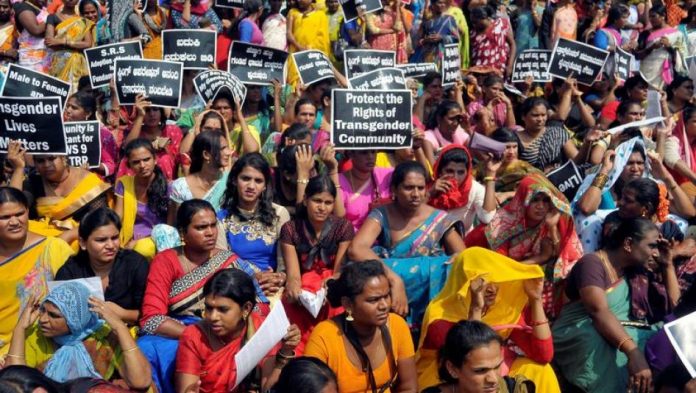This article is written by Vanshika Agarwal, a student from Nirma University, Gujarat.
Table of Contents
Background
The Supreme Court in 2014, in NALSA v. Union of India, gave recognition to fundamental rights of transgender persons and accorded them an equal constitutional status under Indian legal regime. The court upheld the right of self-identification of all persons and declared that hijras and eunuchs can legally identify as “third gender”. The court was of the opinion that biological sex and gender identity are different concepts and while biology is based upon physical characteristics, gender identity cannot be moulded on the precepts of heteronormativity and is dependent upon an innate perception of one’s gender. It was also held that this right of self-identification is derived from constitutional rights and ideas of right to live with dignity under Art 21, equality under Art 14, freedom of sexual expression under Art 19(1)(a) and protection from discrimination under Art 15. The court then directed Central and State Governments to make legal framework to legitimize “third gender” identification and protect the individuals from discrimination, harm, stigma, etc.
Consequently, since then, efforts had been underway to formulate a legislative framework to protect the rights of the transgender community at the central level. In 2014, a private member bill was introduced and passed in the Rajya Sabha called the Transgender Rights Bill 2014. What could have been a beacon of hope and relief for the trans community, soon turned into death knells because of the arbitrary, oppressive and regressive provisions of the Act. The bill lapsed in the Lok Sabha. In July 2019, the Cabinet passed the Transgender Persons Bill 2019 with a general air of apathy, secrecy and neglect, characteristics emblematic of the current rea of legal rule. The provisions of aforementioned bill came into force on 10 January 2020. The now in force Act tries to give statutory recognition to right of self-identification and lays down procedure for recognition of person’s self-perceived identity. It also tries to operationalize fundamental rights guaranteed by NALSA and has a number of provisions prohibiting discrimination and seeking advancement and welfare of the trans community.
Debate on The Transgender Persons (Protection of Rights) Bill, 2019 in Rajya Sabha – 20th Nov 2019
The major and broad points of criticisms mounted against this bill in Rajya Sabha were:
- Lacunae in this Act to take care of the fundamental right of the trans community of self-identity. “The Bill mandates a two-step process : it requires that the person apply for a transgender certificate. This can be done on the basis of the person’s self-declared identity. Then certificate holder can apply for change in gender certificate which signals to the authority to change their legal gender to male or female. This 2nd step appears to require surgery, because they have to get it confirmed by medical authority, then only will they get a certificate. The Bill empowers the DM to judge correctness. The Bill is silent on whether a trans person holding male or female gender certificate will have access to govt. welfare schemes and programmes for trans persons”.
- Lack of provisions to take care of economic opportunities for trans people. Self-employment, entrepreneurship, mainstream education are things that ae needed to be provided to this community for welfare, advancement and entry into the mainstream. Further, The Supreme Court mandated that State and Union govts extend reservations in education and public employment. The current Bill does not treat the transgender community as a socially and economically backward class.
- Lack of grievance redressal mechanism in case of discrimination.
- Lack of adequate penalty for harassment or rape against a transgender person. The penal provisions in the Bill are non-concomitant with penal provisions in other laws (eg- IPC, CrPC) laying down punishment for same or similar offences. Therefore, discrimination exists in punishment mechanism as well. Further, no other law recognizes trans people, so, they can’t access legal mechanisms anywhere else.
Highlights of the Act
- Definition of Transgender person- the acts purports to define transgender person as a person who doesn’t identify with gender assigned at birth and includes trans man, trans woman, kinner, hijra, aravani, jogta, person with intersex variations, genderqueer. It is consequential whether the person has undergone Sex Reassignment Surgery or hormone therapy or laser therapy or such other therapy.
- Identification- The act recognizes self-perceived gender identity. A Trans person has to make an application to District Magistrate for issuance of identity certificate as a trans person.
- Prohibition against discrimination- The Act expressly bans prohibition against Trans people in matters of employment, recruitment, promotion, education, medical healthcare, right to movement, right to purchase, reside or occupy any property.
- National Council for Transgender Persons- The Act mandates Central Government to constitute a National Council for transgender persons to advice, monitor, evaluate, and review the policies and programmes of transgender persons. Another work of this Council is to redress the grievances of trans people.
Criticisms of the Act
Even though the Act gives statutory recognition to the idea of self-perceived gender identity, it states that legal recognition as trans person will only be given on the basis of Certificate of Identity issued by a District Magistrate. However, there is wide academia that exists that states that there should be no mandatory requirement for medical procedure or mental assessment to see whether a person is trans or not. It is innate and doesn’t require qualification of any criteria. S6 of the Act, the procedure hasn’t be laid out as to how or on what basis this certificate of identity will be issued. Arbitrary powers are given to the Magistrate and lack of clarity regarding procedure heavily jeopardizes that object that this piece of legislation seeks to achieve. Further, certificate would be issued on the basis of a set of documents but the important question is which documents would allow transgender persons to be legally recognized and can such documents even exist. The Act also focuses on the archaic need to undergo sex reassignment surgery to get recognized as a trans person and allows the DM to decide the validity of this surgery before giving certificate. Moreover, the person is only allowed to change their first name, implying that last name cannot be changed. This showcases the impervious nature of caste in Indian society and reflects the ethos of a society afraid of actual social mobility. In addition to all of this, if the magistrate rejects the application for certificate, there is no review or appeal provision for this.
Section 12(3) of the Act talks about placing of trans persons in a rehabilitation centre by a competent court, if they are not able to take care of themselves and their families cannot support them. This section inadvertently reflects the understanding of gender as a psychiatric issue. Gender should not be turned into something that requires rehabilitation and psychiatric evaluation.
There is no definition of the term “discrimination” in the Act, which then goes to defeat the purpose of even having it in the first place. If what constitutes discrimination is not understood, then, how can it be stopped. “Establishments have no real obligation to prohibit discrimination against trans persons (Clauses 9-12) as there is no mechanism that would make these establishments comply with the law. Trans persons face tremendous challenges in getting and retaining a job. But if they face discrimination, where is the redressal? The law merely asks the establishment to appoint a Complaint Officer, but what are the functions, how would they respond to a complaint of discrimination? None of this is spelt out in the Act”.
In the Act, provision for penalization of sexual assault prescribes imprisonment for a period of minimum 6 months and maximum 2 years only. If we look at other laws, sexual assault is punishable by imprisonment not less than seven years and maximum of life imprisonment. By virtue of these differing punishments, it can be inferred that the Act discriminates in what can be considered the intensity of crime against trans and hetero people. “The Act should properly enlist the rights of transgender persons to marry and inherit property. Since they are basically unemployed and without a definitely regular income, the Act should provide free sex reassignment surgery, hormonal therapy, laser therapy or any other health treatment for transgender in both public and private hospitals.”
The Act has only formed a National Council. However, State councils should be constituted as well. Trans people reside through the length and breadth of the country and it cannot be considered feasible that they have to approach a body in Delhi in cases of grievances. Moreover, this National Council will only have representation of 5 trans people. This will seriously hamper the welfare of trans community because people without personal experiences will be making laws for them (eg: men deciding abortions laws). Lack of access to justice is the same thing as justice denied and this seems to be happening in the way the provisions seem to be acting.
Lastly, NALSA judgement directed central government to provide for affirmative action for trans persons. State and central govts were asked to extend backward class reservation to transgenders in education and public employment but no such action seems to have been taken.
LawSikho has created a telegram group for exchanging legal knowledge, referrals and various opportunities. You can click on this link and join:
 Serato DJ Crack 2025Serato DJ PRO Crack
Serato DJ Crack 2025Serato DJ PRO Crack










 Allow notifications
Allow notifications



